The new nVidia socket AM2 supporting
chipsets include the nForce 590 SLI for enthusiast class users, the nForce 570 SLI for
high end gamers, nForce 570 Ultra for mainstream gamers and the nForce
550 for the rest of the mainstream market.
Make no mistake, nVIDIA did not simply re-brand its
highly successful nForce4 chipset line, the new nForce 500
series adds many completely new features into the mix. Intel users will have to
wait to the fall before the nForce 5 Intel Edition is set to strike.
Take a quick look at the chart below to see how all four nForce
500-series chipsets stack up to one another; much of the differences reside
with the number of PCI Express lanes available.
| nVidia nForce 500 Series Chipset Feature
Breakdown |
|
nVidia nForce 590 SLI |
nVidia nForce 570 SLI |
nVidia nForce 570 Ultra |
nVidia nForce 550 |
| CPU |
940-pin Socket AM2 |
940-pin Socket AM2 |
940-pin Socket AM2 |
940-pin Socket AM2 |
| nVida SLI Support |
Yes, (2 x16) |
Yes (1 x16, 2 x8) |
- |
- |
| nVidia LinkBoost |
Yes |
- |
- |
- |
| nVidia
FirstPacket |
Yes |
Yes |
Yes |
Yes |
| nVidia DualNet |
Yes |
Yes |
Yes |
- |
|
Native Gigabit Ethernet |
2 |
2 |
2 |
1 |
|
Teaming |
Yes |
Yes |
Yes |
- |
|
TCP/IP Acceleration |
Yes |
Yes |
Yes |
- |
| nVidia MediaShield
Storage |
Yes |
Yes |
Yes |
Yes |
|
SATA/IDE HDD |
6/2 |
6/2 |
6/2 |
4/2 |
|
SATA Speed |
3Gb/s |
3Gb/s |
3Gb/s |
3Gb/s |
|
RAID |
0, 1, 0+1, 5 |
0, 1, 0+1, 5 |
0, 1, 0+1, 5 |
0, 1, 0+1 |
| nVidia nTune
Utility |
Yes |
Yes |
Yes |
Yes |
| PCI Express Lanes |
46 lanes |
28 lanes |
20 lanes |
20 lanes |
| USB Ports |
10 |
10 |
10 |
10 |
| PCI Slots |
5 |
5 |
5 |
5 |
| Audio |
High Definition Audio
(Azalia) |
High Definition Audio
(Azalia) |
High Definition Audio
(Azalia) |
High Definition Audio
(Azalia) |
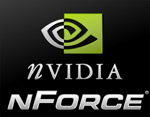 |
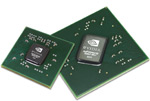 |
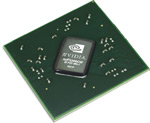 |
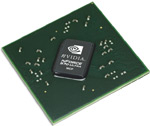 |
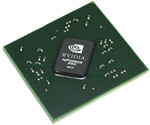
| |
We'll start at the bottom with the nVidia nForce 550 MCP and work our way up. The
nForce 550 MCP supports socket AM2 Athlon64 and
Sempron CPU's. The chipset will support a single PCI
Express x16 videocard, four PCI Express x1 slots and up to five PCI bus
mastering slots. There is only one IDE channel for optical devices, and four
Serial ATA 2.0 connectors for storage devices (RAID 0, 1, 0+1 inclusive). The
nForce 550 designed for affordable motherboards, and so it comes with the
industry standard integrated Gigabit Ethernet network connection, support for
Intel's 7.1 channel Azalia high definition audio codec, and 10 USB 2.0 devices.
nVIDIA's nTune 5.0 Smart performance tuning can also be applied.
Moving up to the nVidia
nForce 570 SLI and 570 Ultra
chipsets, the feature set very similar to that of the nForce 550
MCP. Both are single chip solutions with 16 PCI Express lanes devoted to the
videocard sub system, however the nForce 570 Ultra only supports one videocard
while the nForce 570 SLI supports two. The PCI Express x16 bus is split into two
when SLI is configured so each videocard gets eight PCI Express lanes. There are
an additional four PCI Express x1 slots and five PCI slots for expansion
purposes. Both chipsets have dual Gigabit Ethernet which includes nVidia's
DualNet technology as well as its FirstPacket technology that allows packet
prioritizing. There is one IDE channel, six SATAII connections (RAID modes 0, 1,
0+1 and 5 inclusive), and similar USB and audio options as will all other nForce
500-series chipsets.
The high end nVidia nForce
590 SLI has so many features that nVidia has to use two different
chipsets. ;-) To achieve SLI, the nVidia C51XE Northbridge supports a PCI
Express x16 videocard while the MCP55XE supports a second PCI Express x16
videocard. It's the MCP55XE where most of the action happens, it also supports
two Gigabit Ethernet connection that can take advantage of nVidia's new
networking technologies like DualNet, Teaming and FirstPacket. The IDE, SATA,
audio and USB features are identical to those of the nForce 570 SLI.
Now I know you're thinking that the nForce 590 SLI's
MCP55XE chipset looks a lot like the nForce 570 SLI but there's more. The nForce
590 supports automatic overclocking as well as nVIDIA's LinkBoost technology,
neither is supported by the lower end models. Automatic overclocking is pretty
straight forward, the motherboard automatically overclocks the system depending
on load but it's LinkBoost that's more interesting. When the nForce 590 SLI
chipset detects GeForce 7900GTX or higher videocards installed, it will
automatically increase HyperTransport and PCI Express x16 bandwidth by 25%. This
may not do much for current generation videocards but future generation nVIDIA
videocards will definitely benefit from the added bandwidth!
We've already covered Enhanced Performance Profiles (EPP)
for DDR-2 memory, though we should mention that all nForce 500-series chipsets
support the feature with compatible memory. Nividia are pushing a what it calls
"SLI Ready" memory forward to indicate compatibility with EPP enabled BIOSes,
but I suspect the vendor neutral EPP name will win out in the long run as the
idea is certainly a good one. To recap, EPP takes over where the Serial Presence
Detect (SPD) EEPROM leaves off and allows the motherboard to dynamically adjust
memory timings and voltages for improved overall performance.
With automatic motherboard overclocking already a hit in
the retail market, EPP compatibility adds memory tuning to the performance mix.
EPP will appeal more to the novice or moderate overclocker who does not know or
like to muck around with memory timing adjustments. Enthusiasts can still
override EPP's performance profiles by setting memory timings manually in the
BIOS however.
